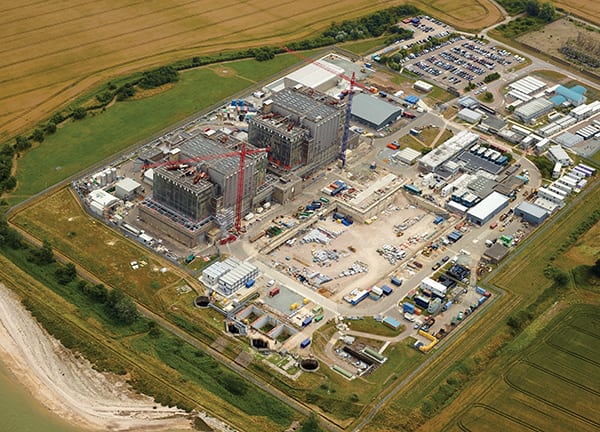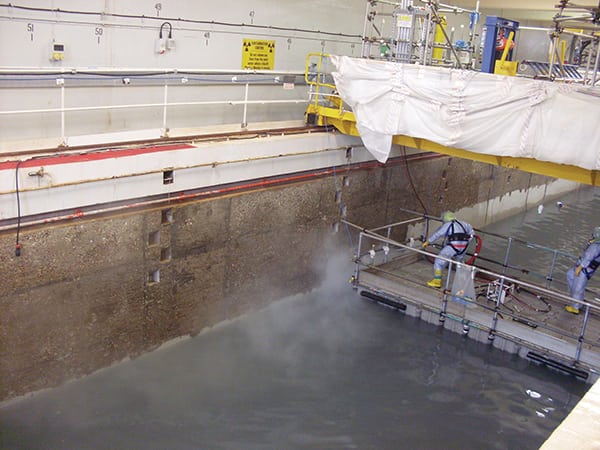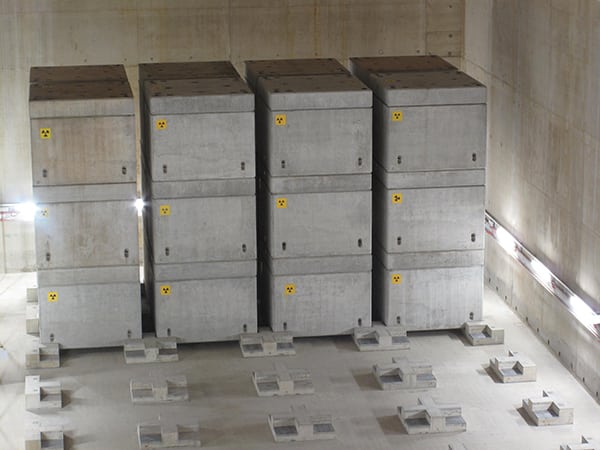UK Uses "Lead and Learn" Strategy for Magnox Reactor Fleet Decommissioning
Energy policy responses to the nuclear disaster at Japan’s Fukushima site, changing economics, and aging first-generation nuclear infrastructure are all contributing to what promises to be a sizeable wave of nuclear plant decommissioning projects worldwide. The United Kingdom has something of a head start, and even though its first-generation reactor technology was unique, its approach to the complicated task of decommissioning may offer lessons for other nations.
Many American readers may not realize that, although the first major nuclear fission successes were achieved in the U.S., after World War II, when nations expanded their nuclear research to include power generation, the United Kingdom (UK) started up the world’s first commercial-scale nuclear power reactor in 1956. The first 26 UK reactors were Magnox design models, and those are reaching the end of their operating lives.
In November 2001, the UK government decided to have taxpayers fund the nation’s nuclear legacy cleanup up front in order to reduce the burden to future generations. Initial developments toward that goal included the creation of a liabilities management authority to ensure that all long-term nuclear liabilities would be managed in a unified way. In this context, the term “liability” describes the financial liability of managing a site when there is little operating income or selling of assets. The term “legacy” distinguishes the first generation of facilities, either shut down or operating, from the proposed “new build” nuclear power stations and newer gas reactor and pressurized water reactor fleet.
This authority, later renamed the Nuclear Decommissioning Authority (NDA, nda.gov.uk) began operating in 2005 and took responsibility for providing a clear and unified approach to decommissioning the UK’s first-generation nuclear sites (1940s to 1960s). In addition to the reactors, nuclear liabilities include fuel reprocessing, fabrication, and enrichment plants plus nuclear laboratory complexes (Figure 1). As in the U.S., many of these legacy facilities were built and operated during the Cold War, thus they require significant liability characterization efforts.
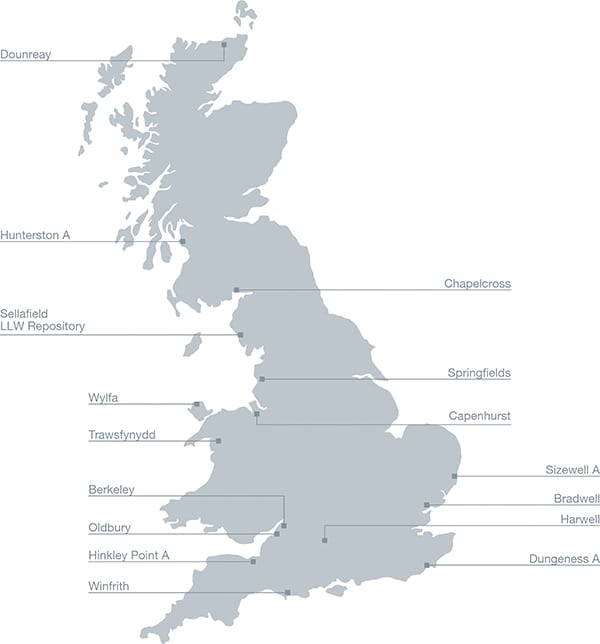 |
| 1. Map of the UK legacy sites. Courtesy: Magnox Ltd./Nuclear Decommissioning Authority |
The NDA recently introduced a “Lead and Learn” strategy that accelerates decommissioning at Bradwell and Trawsfynydd, the first two Magnox stations scheduled to enter into the Care & Maintenance (C&M) phase in 2015 and 2016, respectively. The remaining former power station sites will enter C&M in subsequent years, until 2028.
Innovations and off-the-shelf equipment from outside the nuclear industry are being introduced, where feasible. Lessons learned at Bradwell and Trawsfynydd will eventually be applied across the entire Magnox fleet, achieving C&M status many years earlier than expected for the eight remaining Magnox reactor sites: Berkeley, Chapelcross, Dungeness A, Hinkley Point A, Hunterston A, Oldbury, Sizewell A, and Wylfa.
Magnox Reactors
The complexity of the proposed cleanup was amplified because most facilities, such as the fleet of Magnox reactors, were “one-offs.” Ongoing design modifications and construction methods meant that each new station was slightly more refined, and different from the previous model.
Magnox is short for “magnesium non-oxidizing,” from the magnesium and aluminum alloy–clad reactor fuel rods. Magnox reactors are pressurized, carbon dioxide–cooled, graphite-moderated reactors that use natural uranium as fuel and a Magnox alloy as fuel cladding. The spent fuel could not be stored indefinitely because of its chemical reactivity, so it had to be reprocessed.
The Magnox reactor was the first of eight small prototype units built at Calder Hall and Chapelcross. Although Magnox reactors were initially dual-purposed, combining power generation with plutonium production for military purposes, the latter function was eventually conducted only at Sellafield, which also handled fuel reprocessing. Subsequent units were scaled up for electricity production.
Magnox steel reactor pressure vessels are typically spherical, 20 meters (m) in diameter, weigh 5,000 metric tons (mt), have a nonremovable top, and contain 30,000 to 40,000 individual 60-centimeter fuel elements. Fueling and defueling is conducted through core penetrations using specialized machines. By comparison, U.S. light-water reactors are compact because the reactor vessels are smaller and are designed so that the top can be removed, giving direct access to the reactor core, enabling all of the fuel to be removed in a relatively short period.
Magnox Optimized Decommissioning Program
POWER interviewed Dr. Brian Burnett, head of programs at the NDA, for an inside account of the Magnox Optimized Decommissioning Program (MODP). Burnett confirmed that the NDA’s goal is to decommission existing facilities and restore the sites to delicensed conditions suitable for alternative uses, albeit influenced by the existing level of environmental or health risks and resources needed to achieve a passively safe and secure state.
In the 1990s, “Safestore” was determined to be the preferred UK strategy for decommissioning Magnox power stations. This entails activities carried out in a number of steps, separated by periods of C&M.
Dose decay is initially dominated by cobalt-60, decreasing by orders of magnitude until subjugated by longer-lived radionuclides such as niobium-94 and silver-108m. After 135 years following reactor shutdown, there is no further significant reduction in dose rate over time. The physical, chemical, and mechanical properties of the graphite core within the vessel are not expected to change either during storage or dismantling (see sidebar “The Three Stages of Decommissioning”).
| The Three Stages of DecommissioningThe timing and actions taken during these three stages can vary significantly, depending on a country’s particular waste management policies and strategies.For example, the waste management policy and strategy for England and Wales is to have a geological disposal facility (GDF) ready by 2040. Therefore, it is not sensible to dismantle the reactors now, as the packaged waste would have to be stored on site. When the GDF becomes operational, and with adequate funding, the Nuclear Decommissioning Authority will be in a position to properly dismantle the reactors. Scotland’s emerging strategy is not to have a GDF but to have intermediate level waste stored at or adjacent to a site with the long-term goal of having near-surface disposal and retrievability of that waste.
Stage 1: Post-operational removal of bulk radioactive material. This includes removing fuel from the facility for reprocessing, which removes about 99.9% of the radioactivity from the site. The remaining hazards are primarily associated with the reactor vessels and their internals and operational wastes (such as debris, redundant chutes and control rods, and spent resins). This stage also utilizes traditional chemical and mechanical decontamination methods, such as strippable coatings, scabbling—where several electrically or pneumatically driven piston heads strike simultaneously on a concrete surface to remove radioactive contamination—and cutting apart structures and equipment into smaller pieces using diamond wire or plasma cutting machines. Site safety also focuses on mitigating conventional hazards, typically electrical, chemical, asbestos, noise, working at elevated heights, and confined spaces hazards. Stage 2: Initial dismantling and removal of contaminated parts or care and maintenance. The reactor is left, allowing the radioactive materials to decay. Most of the structures are removed, and the reactor building is left in a safe state that requires minimal supervision until final site clearance. Stage 3: Dismantling and demolition of the structure. Demolition is followed by remediation of land and water to meet an agreed-upon end state for future use. |
Burnett said that in order to accomplish its mission and stimulate competition, the NDA is a single contracting organization for implementing a national integrated strategy consisting of an incentivized, three-tiered contractor and supply chain management program for conducting the cleanup:
- Tier 1: The sites are operated by Site Licensed Companies (SLCs, such as Magnox Ltd.) and their Parent Body Organizations (PBOs, for example, EnergySolutions Inc.) under contract to the NDA. The SLCs hold the nuclear site licenses and are responsible for day-to-day operations and delivery of site programs.
- Tier 2: Tier 2 suppliers work directly with the Tier 1 SLC and subcontract to Tier 3 and below. Services include designing and manufacturing specialized equipment and construction.
- Tier 3: Lower-tier companies fill certain niche requirements. Certain Tier 3 suppliers have worked across multiple SLCs, including the Sellafield, Magnox, and Dounreay sites. Some 2,000 suppliers support Magnox Ltd.
To maintain transparency, the NDA is accountable to the public and the UK government. Milestones are established to monitor progress against clearly defined endpoints. Political, socioeconomic, and timescale options are communicated to a wide range of stakeholders that can affect decision-making outcomes.
Strategic Programs
A significant benefit of the MODP was grouping common strategic programs to effectively apply resources addressing the same core challenges and waste streams across the Magnox fleet.
Fuel Element Debris (FED) Treatment. FED mainly consists of parts of the magnesium alloy cladding that surrounds the nuclear fuel, which, at some sites, was removed before the spent fuel was sent to Sellafield. FED is retrieved and placed into a safe shielded storage container following treatment.
The objective of FED dissolution is to separate radioactive material from inert waste to avoid the unnecessary permanent disposal of the inert waste. At Dungeness A, Magnox Ltd. has pioneered the FED dissolution approach, dissolving FED in an acid solution, reducing the volume by more than 90%. The remaining effluent is treated and discharged, within permitted levels, and items of higher activity are packaged and stored.
Fuel Storage Ponds. Handling of fuel storage ponds involves removing used fuel plus draining and decommissioning the ponds, including the active effluent treatment plants. The ponds stored used fuel elements after they were removed from the reactors, before being sent to Sellafield for reprocessing. Although each pond is different, a consistent six-stage approach was developed: component removal, sludge retrieval, drain and stabilize, contaminated concrete removal/applying sealant, ancillary plant removal, and C&M entry configuration.
Intermediate Level Waste (ILW) Management. Approximately 6,400 cubic meters of wet and solid ILW has been identified for disposal. The majority of waste is currently stored in aging underground vaults and requires fit-for-purpose, on-site storage until the geological disposal facility (GDF) is available for permanent disposal.
At most sites, on-site storage will be achieved through the retrieval of ILW into MiniStores. Weighing 18 mt and containing approximately 2.85 cubic meters of waste each, they provide an alternative to the construction of on-site ILW stores across the Magnox sites. The concept has been used extensively in Europe for more than 20 years, where they are used for interim storage, transportation, and final disposal.
MiniStores have passed a conceptual suitability stage assessment led by the NDA’s Radioactive Waste Management Directorate (RWMD) for permanent disposal in the GDF.
Plant and Structures. Deplanting, demolishing, and remediating structures (including removal of hazardous materials and asbestos), and land so that sites are ready to enter C&M, and the construction and preparation of facilities that will remain during the C&M period. Magnox Ltd. has awarded two major framework contracts for this work. A£304 million deplanting, demolition, and bulk asbestos removal contract was awarded to specialist contractor partners including Doosan Keltbray Consortium, Celadon, Erith, Squibb/LVI Group, Nuvia, and EDS/Silverdell. A framework contract worth up to£300 million over 10 years was recently awarded to Costain and Balfour Beatty. This supports construction, infrastructure, and maintenance projects at all the sites.
Waste Management. Waste management includes maintaining waste inventories, developing disposal routes, and maintaining the company decommissioning strategy, including strategic regulatory engagement. More than 23,977 mt of nonradiological waste and 2,685 cubic meters of radiological waste have been dispatched from Magnox sites. The program continues to manage all waste streams and, where possible, divert nonradioactive waste away from the low-level waste repository to save space.
Early Gains
A C&M Hub has been implemented that will remotely manage all Magnox sites from the C&M preparations phase up to, but not including, the final site clearance (FSC) phase. This includes removal of reactor vessels, building demolition, remediating any contaminated land, and delicensing the sites. The Plant and Structures Program, for instance, is directly engaged with the C&M Hub director regarding end state definitions to ensure that any agreement with the regulator takes into account current proposed end states and associated risks for individual sites.
Since its implementation, the MODP and the C&M Hub have saved more than£1.8 billion compared to previous decommissioning cost estimates delivered in 2010 and have eliminated 34 site-years from the total required to place all sites into C&M. In 2012, this approach achieved international approval of the Vienna-based International Atomic Energy Agency.
“Lead and Learn” Sites
According to Burnett, Bradwell and Trawsfynydd have been identified as “Lead and Learn” sites, where the learning and experience gained will be passed on to other sites before they are required to tackle similar challenges. “Instead of trying to proceed with 10 individual site programs in parallel, it is sensible for us to invest more money on a couple of the stations, then roll out those improvements, program management capabilities, and technologies across the other sites over time,” he said.
The expected results include:
- Mobile teams that vertically integrate with sites, enabling hands-on, cross-site, and cross-disciplinary learning.
- Single points of accountability.
- Consolidated supply chain solutions.
- Managing sites in an optimized sequence to reach earlier C&M entry.
- Affordability by applying proven and consistent solutions.
The goal is to leave both sites with just a handful of facilities in a safe and secure condition, including waste stores and sealed-up reactors that will remain in situ for several decades. The contents are expected to be transferred to the GDF when it becomes operational. Bradwell and Trawsfynydd will be the first to enter this C&M phase in 2015 and 2016 respectively, with the remaining sites entering by 2027–2028.
Another significant benefit expected from the Lead and Learn approach Burnett said, is optimum safety results. By focusing on control and management aimed at major hazards—elevated work, electrical safety, fire safety, chemical safety, confined spaces, and radiological safety—the SLCs’ average rate for 2012/2013 was 128 per 100,000 employees. This is a significant drop from 244 for the previous financial year. As a comparison, the latest statistics from the Health and Safety Executive (similar to the U.S. Occupational Safety and Health Administration) showed an average UK rate of 446 incidents per 100,000 employees.
The Bradwell Project
The SLC and site licensee for the Bradwell site (Figure 2) is Magnox Ltd., the PBO is EnergySolutions Inc., and the site stakeholder group is Bradwell Local Community Liaison Council. Descriptions of recent decommissioning accomplishments at Bradwell follow.
FED Treatment Program. A total of 290 drums have been filled with FED and gravel from vault 1A at Bradwell, the first vault to be completely emptied, marking a major step forward in managing the site’s radioactive waste streams.
The work was not without significant challenges due to the unknown physical condition of the waste, which had been stored for several years. Final retrieval of gravel from the bottom of the vault was achieved by worker access to the area. By pre-planning the entry, the team registered a lower dose rate than forecasted. More than 250 drums of FED have also been removed from a second vault, 1B.
Magnox has, to date, transferred three shipments of FED waste from Bradwell to Dungeness A for dissolution.
As part of its accelerated C&M program, a new dissolution facility at Bradwell is taking shape thanks to the arrival of two reaction vessels in early 2013. The vessels will be where the actual dissolution of the waste, currently being removed from vaults, will be undertaken. Shield walls have also been poured, stainless steel cladding installed, and an overhead crane lifted into place to support operations.
Fuel Storage Ponds. Following fuel element, debris, and sludge removal, ultra-high-pressure water jetting was used to clean Bradwell’s empty fuel storage ponds, reducing operator doses and removing contamination (Figure 3).
After cleaning, a polyurea coating supplied by Protective Coating Solutions Ltd. is sprayed on in a single application using several passes to build up a 4-mm thickness (Figure 4). The polyurea material, typically used as a protective lining for large surface area projects such as tunnels and tanks, forms a durable membrane, improving the stability of the decontaminated surfaces and enabling easier monitoring of potential defects during the C&M phase.
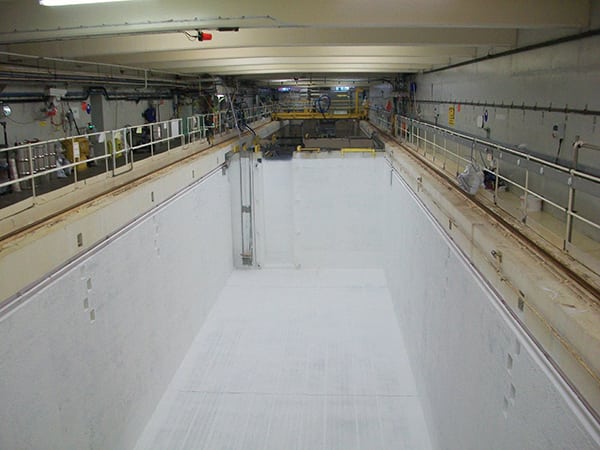 |
| 4. Sealed. A spray-on coating of Dekguard was applied to seal Bradwell’s fuel storage pond walls and floors. Courtesy: Magnox Ltd. |
Innovations such as the use of coatings and pontoons resulted from adapting techniques and off-the-shelf equipment from outside the nuclear industry rather than developing expensive, bespoke solutions.
Intermediate Level Waste Management. To maximize cost efficiencies, a generic interim storage facility (ISF) design for ILW material has been adopted at sites awaiting the construction of medium-term stores, and the first was officially opened at Bradwell.
The generic design allows the ISFs to be constructed to accommodate different numbers of ILW packages, depending on a site’s needs. For example, the ISF will be used to house the ductile cast-iron containers known as yellow boxes until the GDF becomes available.
Plant and Structures. Four, 17-meter-tall charge machines, each weighing around 460 mt, that were used to refuel the nuclear reactors during the site’s operational phase have been dismantled. More than 1,300 mt of redundant equipment have been removed from the pile caps. Meanwhile, the deplanting of boiler houses within the reactor buildings has also progressed. More than 700 mt of recyclable waste—including pipework, external boiler drums, walkways, and stairwells—have been removed.
The Trawsfynydd Project
The SLC and license holder for the Trawsfynydd site (Figure 5) is also Magnox Ltd. The PBO is EnergySolutions Inc., and the site stakeholder group is Trawsfynydd Site Stakeholder Group.
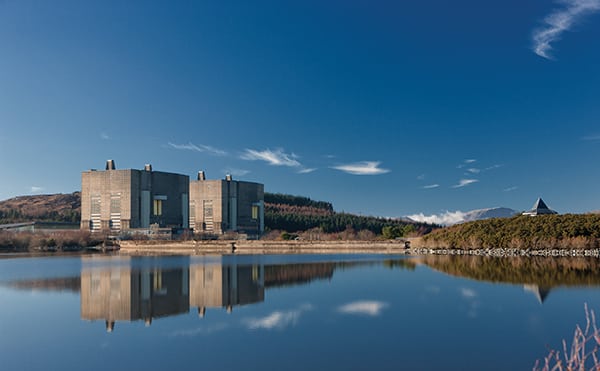 |
| 5. Trawsfynydd site. The Trawsfynydd station is located on a 15.4-hectare site on an inland lake in Snowdonia National Park, Gwynedd, North Wales. Courtesy: Magnox Ltd. |
Trawsfynydd, the first inland civil Magnox nuclear station, operated between 1965 and 1991 and drew its cooling water from Llyn Trawsfynydd, the third-largest lake in Wales. The lake was originally created in the 1920s to supply water to the Maentwrog hydroelectric power station. Defueling commenced in 1993 and was completed 21 months later, during 1995, four months ahead of schedule and under budget.
Other decommissioning successes followed: ponds drained (1998); turbine hall demolition (2003), ponds scabbling commences, complete removal of Reactor 1 boiler section, bulk retrieval of resin from resin vault 1 completed (2006), hot gas duct removal, complete removal of Reactor 2 boiler section (2007), and commissioning an ILW store to house processed and packaged wastes (2009). Height reduction of both reactors is planned for 2020–2026, followed by final site clearance by 2085.
Noncontaminated buildings are being removed to reduce site hazards, leaving only three buildings for C&M in 2016: an ILW store (Figure 6) plus Reactors 1 and 2 in “safestore,” allowing for radioactive decay to a point where the site can be finally cleared by conventional demolition.
Resin Vault Cleanup. Trawsfynydd scored a major first in 2013 by completing the cleanout of radioactive sludge from one of its resin vaults. The three interlinked concrete vaults were built to contain bead and pellet radioactive resins used as a filtering agent to maintain water purity in the cooling ponds. Once spent, the ion-exchange resins formed a sludge-like liquid ILW and were stored in the vaults.
A specially designed remote-operated vehicle (ROV) was used to jet and flush the sludge waste from resin vault 1 into a submerged pump system for transfer into the main sludge vault, ready for encapsulation as ILW. The ROV used a variety of tools to retrieve the sludge, including a plough, high-pressure spray, and wet vacuum system. In total, 5 cubic meters of sludge were retrieved, which follows the recovery of all bulk resins from resin vault 2 in 2012, leaving just the sludge to be removed. Contractors for this phase were NSG Ltd. and EnergySolutions Inc.
Ponds North Void. Work is under way to decommission one of the largest and most complicated radiological hazards on the Trawsfynydd site. Located in the cooling ponds complex, the Ponds North Void (PNV) is a rectangular concrete vault that stored sludge removed from the cooling ponds before transfer to the Main Sludge Vault (MSV). The PNV contains approximately 4.75 cubic meters of liquid sludge and a variety of solid material including FED, nimonic (nickel alloy) springs, pins, and various pieces of redundant equipment. Emptying the void is essential to enable eventual demolition of the ponds.
Because of the diverse waste types and challenging operational environment, Magnox Ltd. is retrieving the material with a unique, specially commissioned rotary deployment arm provided by SA Robotics of Colorado. The process involves filling mesh pots with a mix of FED and sludge using the rotary arm, then washing the sludge off using a combination of supernate (existing contaminated water) and local municipal water.
The process is repeated until each mesh pot is filled just with FED. The sludge in the void is then jet-washed toward a sump and transferred to the MSV. To date, 34 mesh pots have been filled and there have been 40 transfers of supernate/sludge from the PNV to the MSV. Following processing, the various waste streams will be packaged and placed in the ILW store or sent to the national Low Level Waste Repository.
Containerizing a Sludge Filtering and Drying Vessel. A sludge-filtering and -drying vessel constructed in the 1970s, a legacy of the site’s electricity generation era, had high levels of alpha contamination. The vessel was containerized using Nuvia’s reusable and lightweight modular containment system, ModuCon, a glassfiber panel structure mounted in a steel support framework.
Initially, the team was challenged by non-load-bearing floor areas and restricted access around the existing vessel enclosure. This led to an innovative approach where a sectional rail system was designed, enabling the steel support frame to be constructed in a low-radiation area, thus minimizing dose uptake during the installation phase and the risk of damage to the existing tent enclosure already in place.
The rail system spanned the non-load-bearing areas of the workshop floor and allowed the steel frame and partially constructed ModuCon to be pushed into position over the vessel. Once in its final position, the containment end wall was installed and the entry/exit and waste posting facilities were constructed, and the entire unit was sealed. A new, upgraded ventilation system was then connected to the containment.
With the containment in place, teams made numerous entries using air-fed suits and a ventilated environment to reduce the size of the tank, vacuum any ILW waste, categorize and segregate the waste, and then package and consign the waste to appropriate disposal routes.
Safe conclusion of this project marked a major hazard reduction milestone for Magnox. The contractor, Nuvia, was subsequently awarded the Magnox Trawsfynydd Environmental and Safety Award.
It Can Be Done
The NDA’s Burnett summed up the value of the UK’s approach to decommissioning by saying, “There is a collective belief that decommissioning can be expensive and can take a long time. Although the MODP is a new program, by adopting this approach two to three years ago, we have reduced C&M costs by 20%, about£1.5 billion. We are demonstrating to the world that we can do this, we are on track, and very soon we can hold up this [Lead & Learn] example that it can be done.”
As in other nations, dealing with nuclear facilities after shutdown can be done, but it is not cheap, easy, or without unexpected challenges. Recent reports have pegged the annual cost of nuclear decommissioning in the UK—the largest such project in Europe—at£3 billion.
According to the Magnox Lifetime Plan for 2013 that summarizes the key activities, timescales, costs, scope, and resources required to deliver all Magnox sites to the agreed end state, the total expected costs of decommissioning to the point of site clearance are£1.137 billion for Bradwell in 2092 and£1.254 billion for Trawsfynydd in 2083. The Magnox program accounts for roughly 20% of the NDA’s budget, making it the second-largest expenditure after cleanup at the Sellafield site (where fuel reprocessing was handled), which is expected to cost more than£70 billion. ■
— James Hylko is a POWER contributing editor.
